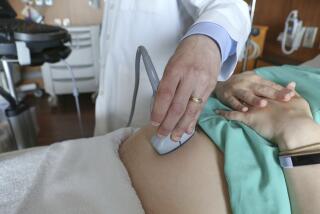County Falls Far Behind in Inspecting Mammography Machines
- Share via
SANTA ANA — The county has fallen so far behind in its inspections of mammography machines that it won’t be able to check them all by June 30, as the law requires.
Jack Miller, director of the county’s Environmental Health Division, said that the delay poses no health risks and that his office is improving its monitoring to ensure that the checks are completed in a timely fashion.
The agency is continuing to investigate complaints about mammogram machines and keep tabs on screening programs that have experienced troubles, Miller added.
“If I were them and couldn’t cover all the inspections, I would pick out the ones that have had the most citations in the past and focus there,” said Dr. Carolyn Kimme-Smith, an associate professor of radiology at UCLA. “That’s the area where I would be worried.”
The backlog stems from a funding dispute between the state and federal governments, which caused the county to halt inspections of mammography devices from January to March.
Funding was restored in April and inspections have resumed, but the Environmental Health Division said it cannot cover nearly 50 inspections it is supposed to complete before the end of the fiscal year. As of April 30, the inspector had completed 50% of federal checks and 35% of state examinations on Orange County’s 95 mammography machines. Federal and state inspections have different requirements.
“We are working as hard as possible to do as many of them as we can,” Miller said. “We won’t get to them all, but we hope to make a dent in it.”
Annual inspections of mammography machines have been required since 1992 as a way of ensuring that the X-ray devices are safe and effective in detecting breast tumors.
Experts said the machines need to be carefully monitored to make sure they don’t emit dangerous levels of radiation or provide doctors with inaccurate images.
“They really should be checked out every year,” said Kimme-Smith. “It would be unfortunate if they cannot inspect them all.”
While chest X-ray machines are checked every three years, mammogram machines require more frequent inspections because patients stand a greater risk of absorbing radiation, Kimme-Smith said.
Annual checks are important, she added, because inspectors make sure mammography operators are keeping accurate records and receiving adequate training.
The state is ultimately responsible for the checks, but it contracts its Orange County inspections to the Environmental Health Division of the county’s Health Care Agency.
*
State officials stopped funding the inspections while they negotiated with the Food and Drug Administration over how much federal funding the mammogram check would receive.
The county’s single mammogram inspector is responsible for making sure machines comply with federal and state standards.
Miller said the inspector should be able to check 15 to 25 machines by the end of June, leaving as many as 30 mammography devices without inspections.
When annual inspections began in the early 1990s, they detected problems in 20% to 30% of mammogram machines. Kimme-Smith said that many deficiencies were minor and that the failure rate has dropped as operators become more familiar with the rules.
Debbie Pellegrini, assistant chief of the state’s Radiological Health Branch, said she expected Orange County to catch up with its inspections soon. “We told them that once we knew about the funding, they were supposed to go at it full time,” she said.
If the county felt the backlog was presenting serious problems, it could ask state radiological inspector to help, Pellegrini said. Miller said the county hasn’t asked for help because he thinks the inspector can handle the job herself and wasn’t sure whether the state would be able to spare any inspectors.
The county’s Environmental Health Division was criticized in a 1996 state audit that found the county failed to adequately monitor hospital and clinic storage and disposal of medical waste. The state threatened to take over the medical waste program, but the county increased the staffing and agreed to make all necessary inspections this year.
Besides mammography, the division is also behind in its inspection of some types of X-ray machines. As of April 30, officials had inspected less than 60% of the machines, but officials hope to check 80% by June 30.
Miller, who became head of the Environmental Health Division late last year, said his office is working to make sure that large backlogs don’t develop.
“We learned from the medical waste situation that we needed better controls in terms of overseeing the program,” Miller said.
More to Read
Sign up for Essential California
The most important California stories and recommendations in your inbox every morning.
You may occasionally receive promotional content from the Los Angeles Times.











